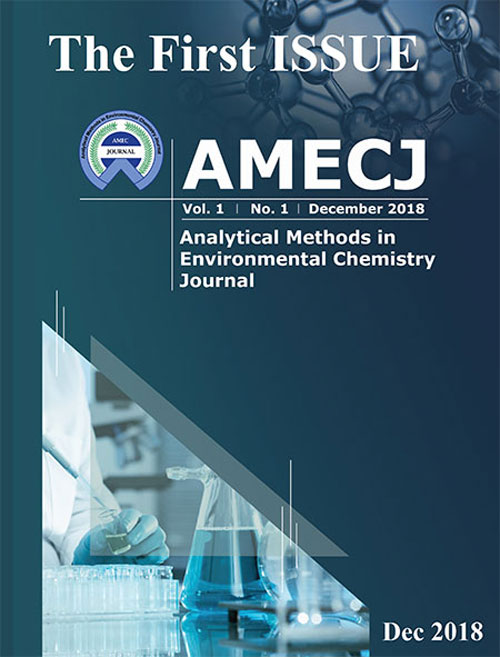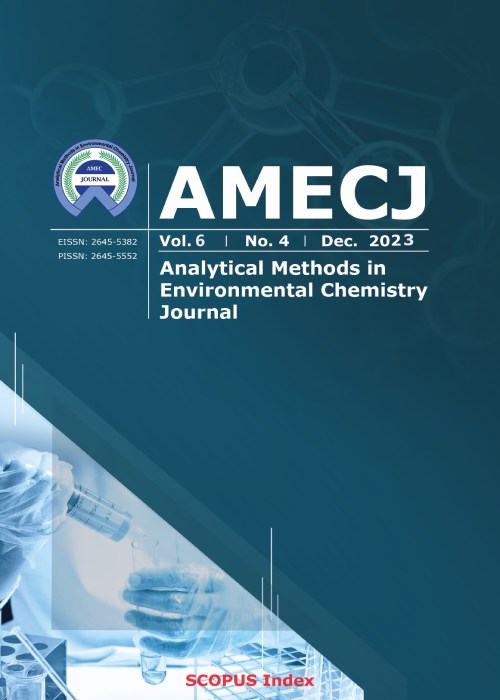فهرست مطالب

Analytical Methods in Environmental Chemistry Journal
Volume:1 Issue: 1, Dec 2018
- تاریخ انتشار: 1397/01/18
- تعداد عناوین: 8
-
Pages 5-10In this work MWCNTs-Fe3O4 nanocomposite was used as an adsorbent for extraction and preconcentration of indium from aqueous solutions. The magnetic MWCNTs with adsorbed analytes were easily separated from the aqueous solution by applying an external magnetic field. After elution of the adsorbed analytes, the concentration of indium was determined using inductively coupled plasma optical emission spectrometry determination. The effects of pH, sorbent amount, eluent type, chelating reagent concentration, sample volume and time on the recovery of the In(III) were investigated. Under the optimum conditions, the detection limit for In(III) was 0.28 μg L−1. The precision of the method, evaluated as the relative standard deviation obtained by analyzing a series of ten replicates, was 3.1 %. The method was successfully applied for the determination of In(III) in environmental water samples.Keywords: Indium, Preconcentration, carbon nanotubes, Fe3O4 nanoparticles
-
Pages 11-22Determination of H2S amounts in crude oil was performed by a precise method instead of UOP163 that were developed in our pervious works. Evaluation of ILs and scavengers were done by two ways. The first one was based on variable concentration of ILs as the scavenger (dynamic method), and the second one was based on a constant concentration of the scavenger during H2S removal process (static method). In the static method, design of experiments was performed for all three tested ILs and three parameters such as time, temperature, and dosage (injection volume) of ILs were investigated. A wide range of time and temperature was also studied according to operating conditions in petroleum terminals.The dose of ILs was obtained from the dynamic method. According to the obtained results, these ILs had a significant effect on H2S reduction in crude oil, so that H2S concentration in some conditions was less than 1ppmKeywords: H2S removal, Crude oil, Ionic liquids, Commercial scavengers, Petroleum refining
-
Pages 23-28In crude oil analysis, the determination of salt content is one of the most important parameters especially for refining and exporting industries. In this study, extraction followed by volumetric titration and electrometric procedure are performed for determining salt content for several Iranian crude oils. Also, the effects of disturbing agents such as increasing associated water for determining salt in crude oil were investigated for both methods. The results show when water content in crude oil is less than 0.05 weight percent, both methods are equally accurate for determining salt content, but when there is an increase in associated water content in crude oil, the electrometric method followed by volumetric titration method shows more accurate results in comparison with the extraction procedure.Keywords: Salt content, crude oil, electrometric method, extraction, volumetric titration
-
Pages 29-38The effect adsorption of cobalt-phthalocyanine-3,4’,4”,4”’- tetrasulfonicacid tetrasodium salt [Co(tsPc)-4•4Na+] onto UVM-7/Ag mesoporous material was investigated. In addition, X-ray diffraction (XRD), scanning electron microscopy (SEM), and nitrogen adsorptiondesorption measurement were used to examine the morphology and the microstructure of the obtained composite. Various parameters including solution adsorbent dosage, contact time, initial dye concentration and temperature were systematically studied. Equilibrium data fitted well the Langmuir models; moreover, the fitness suggests that the adsorption be monolayer and physical in nature. Kinetic studies showed that the adsorption process could be better described by the Lagergren pseudosecond- order models. Thermodynamic constant values (ΔG < 0, ΔH< 0 and ΔS< 0) demonstrated that the adsorption reactions of Co(tspc)-4 onto UVM-7/Ag were feasible, spontaneous, and exothermic under the examined conditions.Keywords: Adsorption, Aqueous, Dye, Isotherm, Mesoporous silica, Kinetics
-
Pages 39-46Eletrochemistry is a broad, useful, and selective technique method in many research fields. Among them, the investigation of performance of electrochemical methods in determination, synthesis and selective reduction/oxidation of different elements and molecules have attracted growing attention due their intrinsic advantages such as selectivity, low cost, and high yield of synthesis. Moreover, electrocatalytic synthesis of organic molecules is known as a green and environmentally benign method. In the present form, electrocatalytic multicomponent transformation of barbituric acid, aromatic aldehydes, and 4-hydroxycumarin was carried out. The electrocatalytic transformation was done in alcohols in the presence of tetrabutylammounium flouride as an electrolyte in an undivided cell containing an iron electrode as the cathode and a Pt electrode as the anode at a constant current leads to substituted chromeno[3’,4’:5,6] pyrano[2,3-d] pyrimidines in good to high yields (54-92%) at room temperature. The yield of reaction was obtained by gravimetric analysis and calculated upon theoretical conversion.Keywords: Analytical methods, Characterization, Electrocatalytic transformation, Chromene, Multicomponent reaction, Pyranopyrimidine
-
Pages 47-56In this research, a magnetic graphitic carbon nitride (g-C3N4-SnFe2O4) was successfully synthesized and utilized as an efficient adsorbent for nickel (Ni2+) separation/extraction from vegetable samples by ultrasound-assisted magnetic dispersive micro solid-phase extraction (UA-M-D-μSPE). After separation and preconcentration step, Ni ions were determined via micro-sampling flame atomic absorption spectrometry (MS-FAAS). A successful synthesis of g-C3N4-SnFe2O4 was investigated by Fourier transform infrared spectroscopy (FT-IR), X-ray diffraction (XRD), field emission scanning electron microscopy (FE-SEM), and vibrating sample magnetometer (VSM). The optimization of adsorption and desorption steps was effectively studied by the on-at-a time method. In addition, under the optimum experimental conditions, the limits of detection (LODs), the linear ranges (LR) and relative standard deviations (RSDs%, for n = 5) were obtained 1.0 μg.L−1, 4.0 ─ 500.0 μg.L−1, and 1.4 respectively.Keywords: g-C3N4, Ni (II), vegetables, SPE, SnFe2O4
-
Pages 57-66The ultrasound assisted- dispersive solid phase microextraction method (USA-SPME) was used for in-vitro study on separation/extraction of calcium ions in human blood of chronic kidney disease (CKD). In this procedure, amine-functionalized bimodal mesoporous silica nanoparticle (NH2-UVM7) as a solid phase was used for in-vitro separation/extraction of calcium from blood/serum samples. Moreover, a mixture of NH2-UVM7 with ionic liquid and acetone (S/IL/Ac) was added to serum/blood sample containing of Ca (II) at pH of 7.3. After ultrasonic bath and centrifuging, NH2-UVM7/ IL settled down in bottom of tube, which was extracted Ca (II) ions by binding to amine group ([Ca]2+ →: NH2 ─ UVM7). The concentration of Ca (II) was determined by flame atomic absorption spectrometry (F-AAS, N2O, C2H2) after back extraction remained adsorbent in IL by 0.5 mL of HNO3 (0.5 M).Keywords: Calcium, Amine-functionalized bimodal, mesoporous silica nanoparticles, Ionic liquid, Human Blood, Ultrasound assisted- dispersive, solid-liquid multiple phase, microextraction
-
Pages 67-74Electrochemical azido-phenylselenenylation of some olefins was studied with the oxidation of diphenyl diselenide in the presence of some olefins and sodium azide in dimethyl formamide containing tetra butyl ammonium perchlorate as supporting electrolyte in an H-type cell. The electrochemical oxidation of the mixture of (PhSe)2, olefins, and NaN3 was studied by cyclic voltammetry and controlled-potential coulometry. Anti product can be obtained with Markovnikov orientation. This product was characterized .by 1H, 13C NMR, and IR spectroscopy.Keywords: Electrosynthesis, Diphenyl diselenide, Markovnikov, Cyclic voltammetry, Controlled-potential coulometry


